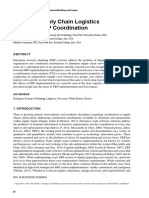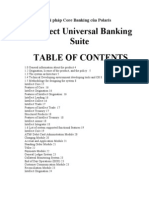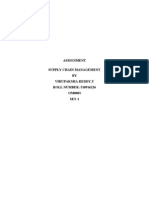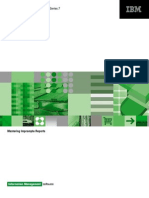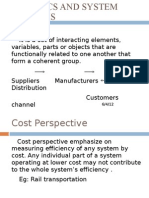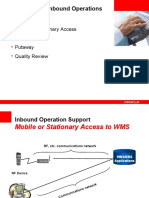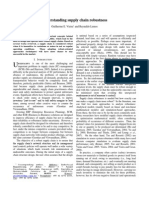Distribution Logistics
Distribution Logistics
Uploaded by
geethamadhuCopyright:
Available Formats
Distribution Logistics
Distribution Logistics
Uploaded by
geethamadhuOriginal Description:
Copyright
Available Formats
Share this document
Did you find this document useful?
Is this content inappropriate?
Copyright:
Available Formats
Distribution Logistics
Distribution Logistics
Uploaded by
geethamadhuCopyright:
Available Formats
In a globalized economy logistics has become a crucial area for the success of companies.
The performance of each company depends on the performance of its suppliers and of its business partners. The customers of each company are spread on a large geographical space. For this reason distribution logistics is the most important and complex part of logistics. An efficient and effective management of distribution logistics is a key issue for the success of a company. There are many different problems to deal with, from facility location to transportation, to inventory management, and, most important, to the integration and optimization of the entire logistics network. Quantitative methods provide relevant tools to support decisions, from strategic to operational, in distribution logistics.
Transportation, distribution and logistics
The logistics behind the distribution of your products and services can have a major impact on your bottom line. Examine ways you can ensure your product distribution methods are optimal.
Transportation and distribution channels
How you distribute your products and deliver your services can affect your cost and your clients' satisfaction. Finding the best method of shipping and receiving goods is especially important when dealing in large quantities. Some factors to consider:
Quantity of items per shipment Type of transportation Overall transportation costs Timing
You can save on costs and improve your customer service by reviewing storage and distribution operations on an ongoing basis. By shortening the amount of time goods spend in a warehouse or in transit, you can deliver them in a more timely manner. Some elements to consider when transporting goods:
Type of products (perishable or non-perishable) Time needed to obtain goods and availability of goods Time needed to deliver goods to the client Access to suppliers (abroad or in Canada) Customs requirements Volume of shipment
You can transport goods by air, sea, rail or road. Each mode has a variety of options that present advantages and disadvantages. Choose the one that will best meet your needs.
Green supply chain management Find out how green supply chain management can save you money and improve your environmental performance in transportation, retail and manufacturing. VentureOne Program Canada Post Are shipping costs increasing your overhead? Consider joining this program to receive up to 8% in savings on parcel and document delivery.
Logistics planning
Logistics is the management of the movement, storage and delivery of your goods or services to the customer. You can use a logistics plan to manage your inventory and keep an eye on costs. Create a plan for the following:
Inbound logistics the flow of raw materials shipped to your business for manufacturing Internal logistics the movement of raw materials and finished goods from one department of your business to another Outbound logistics the preparation for shipment, and the transportation, of the finished products (i.e. packaging, shipping and handling)
By using logistics planning, you can cut down on production costs, speed up delivery and improve the response time for answering client requests.
International markets and logistics
If you are looking for information on how to get your goods to international markets, the following will give you insight on importing, exporting and delivery of your goods.
Export marketing, sales and logistics Get customers in export markets and deliver your goods or services to them.
You might also like
- ISO 41000 - Family of Standards Raising The Bar For FM GloballyDocument35 pagesISO 41000 - Family of Standards Raising The Bar For FM GloballyBudi WibowoNo ratings yet
- Customer Journey Roadmap DFDocument3 pagesCustomer Journey Roadmap DFDzaky FajratamaNo ratings yet
- ATPG Methodology FlowDocument37 pagesATPG Methodology Flowaanbalan100% (2)
- What Is SCM Vision MissionDocument1 pageWhat Is SCM Vision MissionRajat Srivastav100% (3)
- Product HierarchyDocument5 pagesProduct Hierarchygeethamadhu100% (1)
- Super Dual Band SDBDocument6 pagesSuper Dual Band SDBUsama Suhail100% (1)
- Unit 1logistics ManagementDocument13 pagesUnit 1logistics ManagementSidhu boiiNo ratings yet
- Fundamentals of Logistics and Warehousing: The Supply Chain Journey, #4From EverandFundamentals of Logistics and Warehousing: The Supply Chain Journey, #4No ratings yet
- Strategic Benefits of A Global Trade Management Software SystemDocument4 pagesStrategic Benefits of A Global Trade Management Software SystemSileaLaurentiuNo ratings yet
- Global Trade ManagementDocument11 pagesGlobal Trade ManagementFabricPainting KaraHoNo ratings yet
- LLP and 4pl ModelDocument8 pagesLLP and 4pl ModelpradipNo ratings yet
- Company Profile Version KS-Logistic PDFDocument14 pagesCompany Profile Version KS-Logistic PDFCitra WathiNo ratings yet
- LSCM Customer ServiceDocument18 pagesLSCM Customer ServiceAnu AnushaNo ratings yet
- Cib PaperDocument38 pagesCib PaperHAZEM WAGDYNo ratings yet
- Aligning Supply Chain Logistics Costs Via ERP Coordination: Volume 9 - Issue 2 - April-June 2018Document20 pagesAligning Supply Chain Logistics Costs Via ERP Coordination: Volume 9 - Issue 2 - April-June 2018DELIANo ratings yet
- Channel Flow, Design and FunctionsDocument19 pagesChannel Flow, Design and FunctionsAvichal MehrotraNo ratings yet
- Project Description: Marketing in An International Context Group AssignmentDocument4 pagesProject Description: Marketing in An International Context Group AssignmentAhmed HusseinNo ratings yet
- 1 IntroductionDocument47 pages1 Introductionking moon504No ratings yet
- Logistics Costs Study Pakistan Report June 06Document126 pagesLogistics Costs Study Pakistan Report June 06Amna SaeedNo ratings yet
- Giới thiệu giải pháp Core Banking của PolarisDocument18 pagesGiới thiệu giải pháp Core Banking của Polarisdownloadvn10No ratings yet
- A Solution For Cross-Docking Operations Planning For Cross-Docking Operations PlanningDocument7 pagesA Solution For Cross-Docking Operations Planning For Cross-Docking Operations PlanningCem YuceltenNo ratings yet
- Effects of Using Internet of Things (I.o.T) Systems in Transportation On Customer Service DeliveryDocument6 pagesEffects of Using Internet of Things (I.o.T) Systems in Transportation On Customer Service DeliveryInternational Journal of Innovative Science and Research TechnologyNo ratings yet
- Anticipatory Shipping - Predictive AnalyticsDocument11 pagesAnticipatory Shipping - Predictive AnalyticsSandeep KumarNo ratings yet
- SC2x W0 IntroToSupplyChainDesign CLEANDocument32 pagesSC2x W0 IntroToSupplyChainDesign CLEANAmr M. AbdelhadyNo ratings yet
- 2015 2020 CTRM Market OutlookDocument17 pages2015 2020 CTRM Market OutlookCTRM CenterNo ratings yet
- Traceability InventoryDocument34 pagesTraceability InventoryM. Farhan Ajar GemilangNo ratings yet
- Office AutomationDocument39 pagesOffice AutomationVickram JainNo ratings yet
- Assignment Supply Chain Management BY Virupaksha Reddy.T ROLL NUMBER: 510916226 OM0003 SET-1Document12 pagesAssignment Supply Chain Management BY Virupaksha Reddy.T ROLL NUMBER: 510916226 OM0003 SET-1virupaksha12No ratings yet
- Retail Logistics and ITDocument22 pagesRetail Logistics and ITRakeysh CoomarNo ratings yet
- Sap Terp10Document2 pagesSap Terp10Tapas BhattacharyaNo ratings yet
- Logistics NotesDocument18 pagesLogistics NotesRadha Raman SharmaNo ratings yet
- ERP Planning, Design and ImplementationDocument20 pagesERP Planning, Design and ImplementationKshitij LauNo ratings yet
- 2017 EFT Global Logistics ReportDocument19 pages2017 EFT Global Logistics ReportcarupiaNo ratings yet
- Supply Chain Planning Modelling and AnalyticsDocument10 pagesSupply Chain Planning Modelling and AnalyticsAnil RanasingheNo ratings yet
- Echnical AND Usiness RitingDocument10 pagesEchnical AND Usiness RitingRafshan ImbisaatNo ratings yet
- WaridDocument30 pagesWaridMakkia ShaheenNo ratings yet
- Mastering Impromptu 7.5Document195 pagesMastering Impromptu 7.5idaya_cnNo ratings yet
- Chap 12 Performance Measurement FINALDocument14 pagesChap 12 Performance Measurement FINALOnkar SawantNo ratings yet
- Recipe DevDocument46 pagesRecipe DevKishorNo ratings yet
- Developing Reverse LogisticsDocument121 pagesDeveloping Reverse LogisticsdbedadaNo ratings yet
- Information Systems For Competitive AdvantagesDocument15 pagesInformation Systems For Competitive Advantageskira5729No ratings yet
- Logistics and System AnalysisDocument22 pagesLogistics and System AnalysisAvinash Hacholli0% (2)
- Stock Transport With Delivery - ERP SCM - SCN WikiDocument6 pagesStock Transport With Delivery - ERP SCM - SCN WikiTrinadh PitchukaNo ratings yet
- ERP Maritime ERPDocument22 pagesERP Maritime ERPশারিকা নাহিদ100% (1)
- Supply Chain Management-Historical PerspectiveDocument7 pagesSupply Chain Management-Historical PerspectiveTalha SaeedNo ratings yet
- SCOR MetricsDocument2 pagesSCOR MetricsCapsLock610No ratings yet
- The Development of Enterprise Resource Planning SystemsDocument9 pagesThe Development of Enterprise Resource Planning SystemsNeha SharmaNo ratings yet
- Lecture 20 Logistics & Supply Chain ManagementDocument75 pagesLecture 20 Logistics & Supply Chain ManagementNeelamanshu MishraNo ratings yet
- Data Analytics in Warehouse Management Systems (WMS) ImplementationsDocument5 pagesData Analytics in Warehouse Management Systems (WMS) ImplementationsMinh HoàngNo ratings yet
- Procter & Gamble - Gillette, United Kingdom: Warehousemanager Loadbuilder ModuleDocument4 pagesProcter & Gamble - Gillette, United Kingdom: Warehousemanager Loadbuilder ModulesomarritadNo ratings yet
- What Is SAP Erp5Document20 pagesWhat Is SAP Erp5Venkatesh KlNo ratings yet
- A Baseline Document Is Defined As Any Official Document That Has Gone Through An Initial Approval Process and Was Approved For Use As IntendedDocument5 pagesA Baseline Document Is Defined As Any Official Document That Has Gone Through An Initial Approval Process and Was Approved For Use As Intendedprasanthp100% (2)
- ERP Implementation in RRDocument5 pagesERP Implementation in RRkahfi_imamNo ratings yet
- Bharat Petroleum Corporation Limited (BPCL) Year of Implementation: November 2001 - SAP R/3 Why Company Wanted To Implement ERPDocument4 pagesBharat Petroleum Corporation Limited (BPCL) Year of Implementation: November 2001 - SAP R/3 Why Company Wanted To Implement ERPRohit CharpeNo ratings yet
- C CCCC C CCCCCCCCCC CCCCCCCCCCCCCCCC C: CC CCCCCCCC C CCC CCC C CCDocument8 pagesC CCCC C CCCCCCCCCC CCCCCCCCCCCCCCCC C: CC CCCCCCCC C CCC CCC C CCSanna SalimNo ratings yet
- Resume GopalakrishnanDocument2 pagesResume GopalakrishnansymongkryshNo ratings yet
- Inbound Cross DockDocument135 pagesInbound Cross DockSonaliNo ratings yet
- Aggregate PlanningDocument7 pagesAggregate PlanningbalashankarrNo ratings yet
- Understanding Supply Chain RobustnessDocument6 pagesUnderstanding Supply Chain RobustnessGuilherme VieiraNo ratings yet
- MRP Business Benefits-2Document10 pagesMRP Business Benefits-2AshNo ratings yet
- Kazef Chan Resume - 2021Document5 pagesKazef Chan Resume - 2021Candice CheungNo ratings yet
- Chapter 6 Production Activity Control - Powerpoint PPT PresentationDocument17 pagesChapter 6 Production Activity Control - Powerpoint PPT PresentationsivaNo ratings yet
- Three Principles of Transportation Optimization JDA White PaperDocument4 pagesThree Principles of Transportation Optimization JDA White Paperismailhasan85No ratings yet
- Accord Business School, Tirupati.: 106 - Quantitative TechniquesDocument2 pagesAccord Business School, Tirupati.: 106 - Quantitative TechniquesgeethamadhuNo ratings yet
- Quiz StatisticsDocument22 pagesQuiz StatisticsgeethamadhuNo ratings yet
- 8c43 HarishDocument3 pages8c43 HarishgeethamadhuNo ratings yet
- DAM Example ProblemsDocument13 pagesDAM Example ProblemsgeethamadhuNo ratings yet
- DSS Program StructureDocument1 pageDSS Program StructuregeethamadhuNo ratings yet
- DAM Example ProblemsDocument13 pagesDAM Example ProblemsgeethamadhuNo ratings yet
- Unit 6 Strategic Retail Planning Process: ObjectivesDocument18 pagesUnit 6 Strategic Retail Planning Process: ObjectivesShweta ChaudharyNo ratings yet
- Index Numbers Are Meant To Study The Change in The Effects of Such Factors Which Cannot Be MeasuredDocument2 pagesIndex Numbers Are Meant To Study The Change in The Effects of Such Factors Which Cannot Be MeasuredgeethamadhuNo ratings yet
- Action Research HandoutDocument2 pagesAction Research HandoutgeethamadhuNo ratings yet
- PVC PipesDocument6 pagesPVC PipesgeethamadhuNo ratings yet
- Explanation For The Statistical Tools UsedDocument4 pagesExplanation For The Statistical Tools UsedgeethamadhuNo ratings yet
- Competency MappingDocument2 pagesCompetency MappinggeethamadhuNo ratings yet
- Human Resources Management: StaffingDocument11 pagesHuman Resources Management: StaffinggeethamadhuNo ratings yet
- Default Forms, Reports and DatabasesDocument9 pagesDefault Forms, Reports and DatabasesgeethamadhuNo ratings yet
- Business Policy and Strategic Management 2 Marks (Points and Concepts Only)Document33 pagesBusiness Policy and Strategic Management 2 Marks (Points and Concepts Only)geethamadhuNo ratings yet
- Teaching Styles For Teaching EffectivenessDocument6 pagesTeaching Styles For Teaching EffectivenessSingam SridharNo ratings yet
- PeopleSoft Campus Solution 9.2 InstallationDocument52 pagesPeopleSoft Campus Solution 9.2 InstallationWandheeNo ratings yet
- Syllabus AMATH301Document3 pagesSyllabus AMATH301bravoNo ratings yet
- B EIM GRADE 12 Q1M1 Learner Copy-TVL Final LayoutDocument25 pagesB EIM GRADE 12 Q1M1 Learner Copy-TVL Final LayoutMark Ragos100% (1)
- IndexDocument35 pagesIndexCésar Cusi LazoNo ratings yet
- 8 Risks and Dangers of Artificial Intelligence (ADocument2 pages8 Risks and Dangers of Artificial Intelligence (AKunsel Bodh 6th b 13No ratings yet
- Question: Match Each Discrete-Time Signal With Its DFT. You Should Be AblDocument3 pagesQuestion: Match Each Discrete-Time Signal With Its DFT. You Should Be AblThePositive GuyNo ratings yet
- CIDEON ECTR Interface To SolidEdge Configuration ManualDocument86 pagesCIDEON ECTR Interface To SolidEdge Configuration ManualBilal KaraNo ratings yet
- Cross-Docking - SAP Quick GuideDocument6 pagesCross-Docking - SAP Quick GuideSUBHOJIT BANERJEENo ratings yet
- 0053Document1 page0053superowelNo ratings yet
- CTA Remote Interface ManualDocument217 pagesCTA Remote Interface ManualTomas RuizNo ratings yet
- Disadvantages of New Technology in Communication Argumentative EssayDocument4 pagesDisadvantages of New Technology in Communication Argumentative Essaylontajo136534140574depedqc.phNo ratings yet
- Installation, Support, and Maintenance Guide: X7 Series Satellite RouterDocument66 pagesInstallation, Support, and Maintenance Guide: X7 Series Satellite RouterEddy GuttyNo ratings yet
- AN1207 For MC145170Document6 pagesAN1207 For MC145170ftbenji123No ratings yet
- Amoled Display: BY AbhinavDocument17 pagesAmoled Display: BY Abhinavcharithacherry123No ratings yet
- Activities:: Work-.Addwork Work-.AddDocument3 pagesActivities:: Work-.Addwork Work-.Addjithendra babuNo ratings yet
- FEI Quanta 400 FEG - FEI CompanyDocument2 pagesFEI Quanta 400 FEG - FEI CompanyGrégory PezzattiNo ratings yet
- Tesla Chargers ManualDocument61 pagesTesla Chargers ManualDsntNo ratings yet
- Challenges of Modern YouthDocument4 pagesChallenges of Modern YouthGautam VermaNo ratings yet
- Chiller Perfomance TestDocument8 pagesChiller Perfomance TestunnicyriacNo ratings yet
- Leader Election (Ring LE & Bully LE Algorithm) : Cloud Computing and Distributed SystemsDocument55 pagesLeader Election (Ring LE & Bully LE Algorithm) : Cloud Computing and Distributed Systemskuntal.kgec.cse3239No ratings yet
- Set No.1: Time: 3 Hours Max. Marks: 80Document53 pagesSet No.1: Time: 3 Hours Max. Marks: 80api-26343009No ratings yet
- Forced-Convection Laboratory Ovens For Evaluation of Electrical InsulationDocument3 pagesForced-Convection Laboratory Ovens For Evaluation of Electrical InsulationMa PonyNo ratings yet
- Backend ChallengeDocument7 pagesBackend ChallengeMian ShazyNo ratings yet
- Chapter 2 Configuring A Network Operating SystemDocument8 pagesChapter 2 Configuring A Network Operating SystemCarol MendezNo ratings yet
- ReademDocument2 pagesReademkumd700No ratings yet
- 2 What Is Philosophy of Technology by Andrew FeenbergDocument11 pages2 What Is Philosophy of Technology by Andrew FeenbergLin GuillermoNo ratings yet















